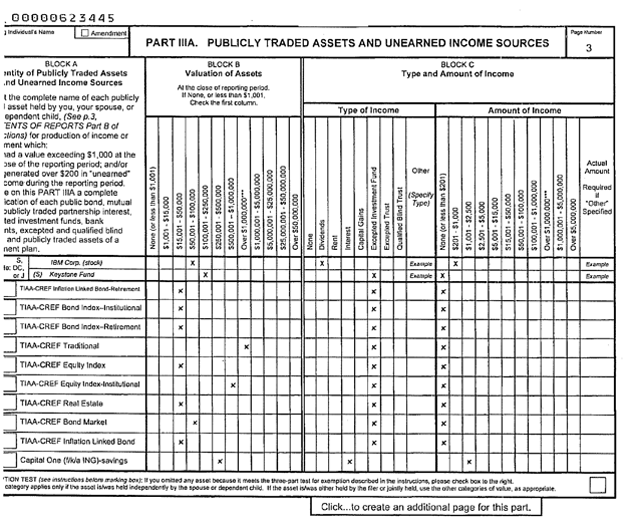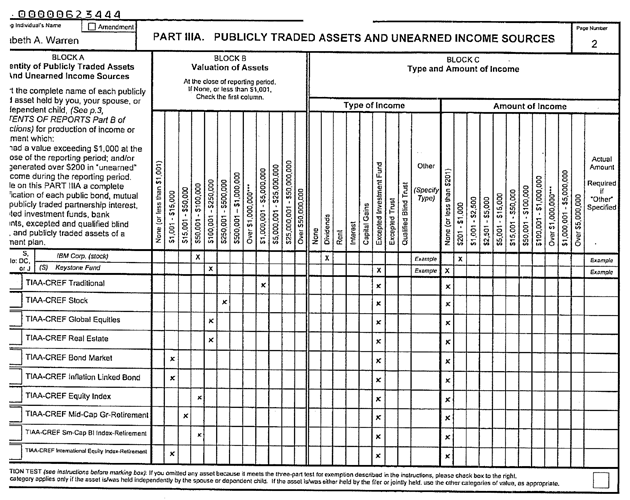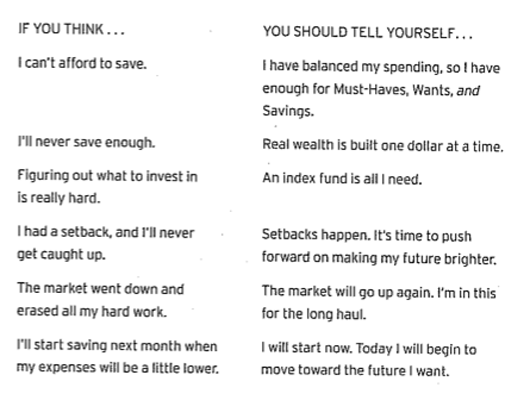
Jay Mallin/ZUMAPress
Along with her reputation as a crusader for the middle class and scourge of bad banks, Sen. Elizabeth Warren (D-Mass.) also has a history as a personal finance guru. In 2005, the former Harvard law professor, who is worth between $2.8 and $12 million, cowrote with her daughter a no-nonsense, no-magic-bullets financial advice book called All Your Worth: The Ultimate Lifetime Money Plan. We’ve cross-referenced Warren’s recently released financial disclosure forms with the book to distill the essence of her financial-planning wisdom. Now you, too, can invest like a populist defender of the public interest.
FIRST THINGS FIRST
Get debt free: “Drain your savings account, empty your checking account, and sell any stocks or bonds,” Warren writes in All Your Worth. “Cash out the bar mitzvah money, crack open Mr. Piggy, and shake out the cushions from the couch…It’s time to focus some laser-beam intensity on paying off your debt.” What about credit cards? “Okay, we’re not fanatics (although we’re close). One credit card may be okay for emergencies.”
Warren has followed her own advice—she has essentially no debt: no mortgage debt, no credit card debt. She is paying off a $15,000 student loan, but—get this—it has a zero percent interest rate. “Wouldn’t everybody love to have that?” says Chris Farrell, the economics editor of American Public Media’s Marketplace. When you’re worth millions, he says, “That’s more of a rounding error rather than a liability!” Other senators’ financial disclosures list hundreds of thousands of dollars of credit card and mortgage debt.
Don’t buy a sailboat if you work at Wendy’s (or are a journalist): Fifty percent of your income should go to Must Haves, Warren says—that is, things like food and housing. Thirty percent should go to Wants. Examples from Warren’s book include: light beer, dinner at Olive Garden, a hamster, a Madonna CD, and a pot of begonias. The remaining 20 percent should go to savings. If this formula means you have to sell your car, so be it, Warren argues.
Pay off your mortgage if you have one: Once you’re out of debt, take 5 percent of your monthly savings and use it to pay extra on your mortgage. “You may think that paying a couple hundred dollars extra every month is like trying to bail out the ocean with a teaspoon. But you may surprised just how far that little extra can go.”
HERE’S HOW TO INVEST
Visualize: “Take a moment to savor your dream. Picture the sunlight reflecting on the lake while your husband proudly holds up a string of trout. Imagine Katie, all grown up in her robe and cap, proudly accepting her diploma.”
Create a retirement fund: Now, steer 10 percent of your monthly savings into an individual retirement account (IRA) or 401(k). “If you have a retirement account and you are putting money in it, then you have just made it into the upper half (financially speaking) of all adults in the US. Hot dog!”
According to Warren’s financial disclosure forms, she has between $96,000 and $265,000 invested in various retirement funds through the Teachers Insurance and Annuity Association-College Retirement Equities Fund (TIAA-CREF), a financial services organization that is also the leading retirement provider for people in academic fields. She also has between $15,000 and $50,000 of her retirement savings invested in a Vanguard mutual fund. Farrell approves of the amount Warren has tucked away for her golden years and the companies she has chosen to invest with, which he says are “low-fee and transparent.” Warren “is going to have pretty good retirement income,” he says.
This page in Warren’s financial disclosure shows a few of her retirement funds:

Invest prudently in the stock market: Take the remaining 5 percent (or 10 if you’ve paid off your mortgage) of your monthly savings and invest it in the stock market. “Picking an investment is not so different from picking a car. There are people who love nothing more than searching for an exotic car,” Warren writes. “They dedicate their days and nights to studying muscle cars and antique cars, and maybe after all those hours, they drive something really cool. It is even possible that some of them make a little money when they happen upon something really special that they can buy for a good price. Then again, most of them lose their shirts at the repair shop.” It’s probably a better idea to “buy something safe and reliable with good gas mileage and enough room for the groceries.”
Warren recommends investing in an indexed mutual fund, which buys stocks from hundreds or thousands of different companies, so that even though individual stocks fluctuate, over the long-run you’re probably safe. “The index fund is essentially the Honda Civic of the investment world.”
Warren has a total of between $1,517,000 and $6,180,000 invested in several accounts through TIAA-CREF. She has the largest share invested in an annuity, which is a payment to a life insurance company that then is distributed back in fixed payments to the buyer later in life. And she has money in various mutual funds and variable annuities, which work a lot like mutual funds. Sean O’Shaughnessey, a private investor and author of the book The Confident Investor, says the way Warren has invested her money is a little too conservative for him, but calls it a “prudent investment strategy.” Farrell says Warren has a “low-worry” portfolio. “She has pretty much set it up so that she doesn’t have to worry,” he says. “I like it.” Here’s a list of Warren’s biggest investments:
- $1-$5 million in a traditional annuity account in which TIAA-CREF assumes the risk for the performance of the underlying stocks, and pays out a guaranteed amount per month later on.
- $250,000-$500,000 in a variable annuity that invests mostly in common stocks of a diversified set of companies, such as Apple, Exxon, PepsiCo, and Wells Fargo. Variable annuities are annuities in which the investor, not the insurance company (in this case TIAA-CREF), takes on most of the risk for the performance of the underlying stocks. That is, their value rises and falls with the market, like a mutual fund.
- $100,000-$250,000 in a variable annuity that invests in stocks of foreign and domestic companies, with a focus on companies that are “shareholder-oriented.” Some examples: Nestle, BNP Paribas, Royal Dutch Shell, Johnson & Johnson, and Toyota.
- $100,000-$250,000 in a mutual fund that invests in various types of real estate around the country.
- $50,000-$100,000 in a mutual fund that invests in US companies like Visa, Goldman Sachs, NewsCorp, Monsanto, and eBay.
- $15,000-$50,000 in a mutual fund that invests in government bonds and mortgage-backed securities held by government-supported mortgage financiers such as Ginnie Mae and Fannie Mae.
- $1,000-$15,000 in a variable annuity that invests in the same things, as well as corporate bonds, including those of GE, Comcast, and AT&T.
- $1,000-$15,000 in a mutual fund that invests mostly in US Treasury notes that are tied to the inflation rate (so you don’t lose money).
Here is the page of Warren’s financial disclosure forms showing her investments in annuities and mutual funds:

Not everyone can expect their portfolio to look like Warren’s. The senator has been able to pack away a significant amount of money because she has made a pretty penny teaching and writing books. At Harvard, her annual salary was $430,000; in 2012, she took in $9,000 from the school as an emeritus professor. Last year, Warren got about $64,000 in royalties and salary from Aspen Publishers, which has published many of her academic books. In 2011, she took in around $700,000 total from Harvard, book royalties and consulting fees. As a senator, she earns $174,000 a year.
Oh, and avoid investing in these:
- Gold.
- Prepaid funerals.
- Collectibles such as “Franklin Mint medals, autographed footballs, [or] rare stamps.”
AND IF YOU GET NERVOUS ABOUT ANY OF THIS
Here are some ways to avoid “negative-thinking traps”:














